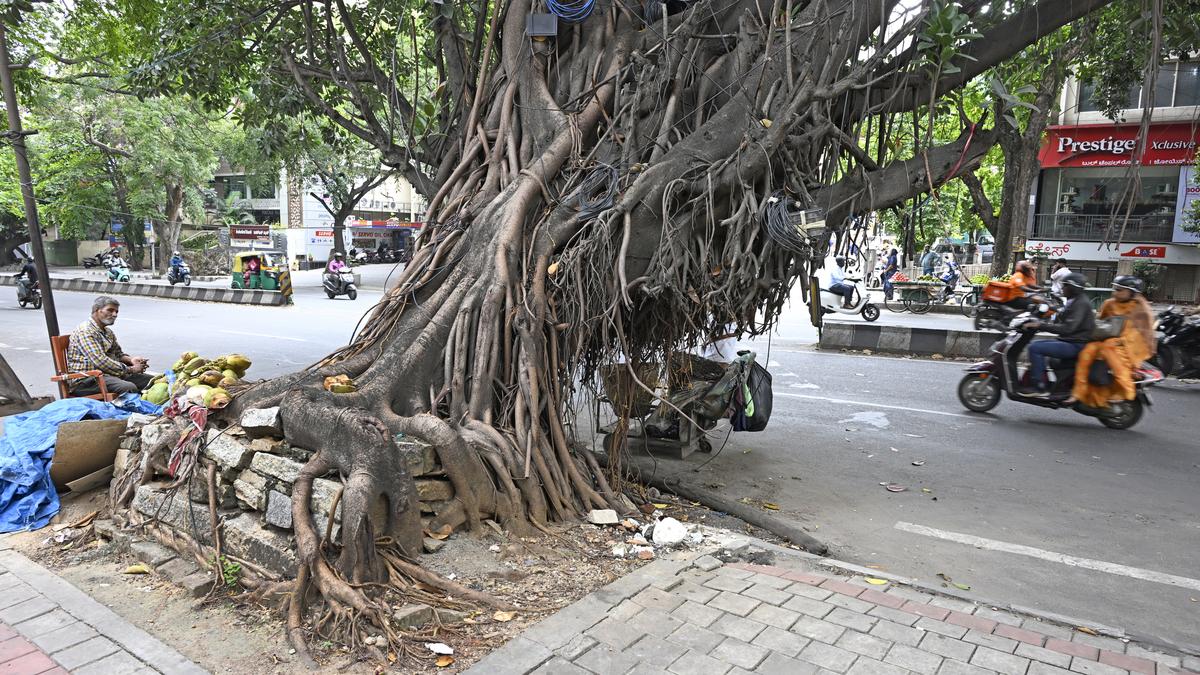
Getting to the root of Bengaluru’s tree-falls Premium
The Hindu
Bengaluru's tree diversity, threats, and conservation efforts highlighted by experts, emphasizing the importance of urban green cover.
Seventy-six-year-old Bhadraiah takes time off from his stall in Jayanagar III Block, where piping hot bajjisare made, when asked about a grand banyan tree on the road where his shop and house are located. “I’ve seen this tree ever since I moved here 50 years ago. Even the Bruhat Bengaluru Mahanagara Palike (BBMP) won’t take it down, nor will the residents here allow it, because it’s a sacred tree and it’s dear to all of us,” he says.
In east Bengaluru, at BEML Gate on the ever-busy Suranjandas Road, another tree has no such luck. Its roots stand exposed, almost unnaturally manicured, as work goes on beside it on the construction of an enclosure for the Kempegowda statue that was installed here.
Bengaluru, once known as the Garden City of India, in its transition to becoming the IT capital, has seen a rapid loss of green cover. As extreme weather conditions are becoming increasingly frequent, and with experts also flagging the urban heat island phenomenon, the need to pay more attention to the ecology of the city has become more apparent than ever.
Ecologists say Bengaluru’s tree diversity is much larger compared to other big cities. Harini Nagendra, Director of the School of Climate Change and Sustainability at Azim Premji University (APU), said the city has a large palette of over 50 species that have historically been used for greening in different areas.
“In most other large cities across the world, a handful of species predominate, reducing biodiversity and also making the species prone to diseases that can sweep through quite quickly, damaging old trees. Partly because of the city’s colonial heritage, and partly because of an older Indian tradition of planting a variety of keystone species like peepal and banyan, Bengaluru has always drawn on a large variety of trees,” she said.
Offering an example, she said one species — the ash tree — makes up close to 20% of all trees in Chicago, but this tree has been subjected to attack by the emerald ash borer, a beetle from Asia that spreads quickly, and now threatens the survival of hundreds of thousands of ash trees in Chicago and many other midwestern US cities.
“Increasing tree biodiversity helps make urban tree populations more resistant to such diseases, and Bengaluru has an advantage here. Some of this is, unfortunately, changing. For instance, in sacred spaces – temples, churches, mosques and cemeteries — we find trees of high species diversity, as well as on roadsides. But in gardens and parks, we find a few species predominate. Similarly, plant diversity is very low in landscaped gardens but high in informal settlements, especially the diversity of native plants, which many of these households grow to use in cooking and as herbal medicines,” said Harini.





















 Run 3 Space | Play Space Running Game
Run 3 Space | Play Space Running Game Traffic Jam 3D | Online Racing Game
Traffic Jam 3D | Online Racing Game Duck Hunt | Play Old Classic Game
Duck Hunt | Play Old Classic Game











